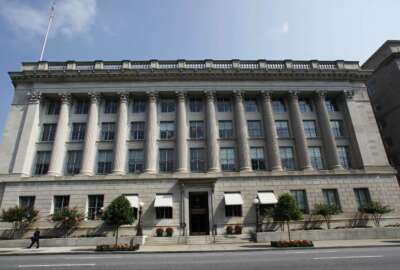
Infrastructure is ready for America, but is America ready for infrastructure?
Recently the American Society of Civil Engineers confirmed that the nation's infrastructure could stand some rebuilding. For more, Federal Drive turned to civil...
Best listening experience is on Chrome, Firefox or Safari. Subscribe to Federal Drive’s daily audio interviews on Apple Podcasts or PodcastOne.
Congress, with the backing of the Biden administration, is going to make a fresh run at funding for the nation’s infrastructure. Recently the American Society of Civil Engineers confirmed that the infrastructure could stand some rebuilding. For what impact the Biden plan could have and how to pick the most worthy projects, Federal Drive with Tom Temin turned to civil engineer and former ASCE president, Greg DiLoreto.
Interview transcript:
Tom Temin: Mr. DiLoreto, good to have you on.
Greg DiLoreto: Thank you for having me.
Tom Temin: And looking at this bill, it does propose quite a bit several 100 billion dollars directly for engineering projects and infrastructure projects. As we classically understand infrastructure, what does it look like could be the Delta in spending per annum on this type of infrastructure versus what the nation now spends? Do you think,
Greg DiLoreto: As you know, for every four years, we’ve been looking at infrastructure and doing a report card that we give a grade on the condition of our nation’s infrastructure, we just released our last 121, I hear in March, and the grade for the entire infrastructure, 17 categories was a C minus first time we ever got there. That was the good news. The bad news was that 11 of those categories still get a grade in the Ds, and four got Cs and two got Bs. Now we also look at what the cumulative investment need is on those 17 categories. And between 2020 and 2029, we show needs to bring our infrastructure up to a greater be good condition meets our needs of almost $6 trillion, we show that we currently have funding or anticipated funding of around $3.4 trillion. And so we have a funding gap of around $2.6 trillion. And so it’s that gap, that delta that we’re hoping this package will help close, we’re realistic, that it’s not entirely federal government’s responsibility to close that gap, but then certainly need to be a partner. And that’s something they haven’t been over the last several years in helping local governments, which are most of the infrastructure, doing things that will close the gap, and make sure wherever you are in this country, the infrastructure is good for your economic prosperity and quality of life.
Tom Temin: I was gonna say we’re talking about publicly owned infrastructure, the traditional roads, bridges, and so on, not so much private infrastructure such as pipelines — correct?
Greg DiLoreto: For the most part, although we do grade infrastructure by category, not by who owns it. So for example, we have rail, which got our highest grade at a B most rail is privately owned, we also grade the electrical grid, and much of our electrical grid is privately owned. So we’re really grading the infrastructure not classifying who owned it, but you’re correct. By and large, the majority is owned by local governments, whether it’s our road system, or the sewer system, or the drinking water system that you use every day, primarily are owned by some local government.
Tom Temin: And by the way, what is the grade for the grid overall?
Greg DiLoreto: Yeah, so the energy grade was a C minus system.
Tom Temin: Okay, so not quite falling to pieces and ready to cause widespread blackouts, but not where we need it.
Greg DiLoreto: No, but close. Yeah, I mean, it’s barely above a D plus, which is at risk and poor condition. So I mean, it’s right down there where it needs attention.
Tom Temin: There’s many hundreds, I guess, 1000s of potential projects, then when you add up all of these categories across the country, what’s a good process or way of thinking about them in order to, should this funding come through, in some manner to prioritize them? How do you know what to do first?
Greg DiLoreto: Well, two things. One, we never look at one particular category as being more important than the other because what we have found is our infrastructure is tied together. So for example, you can take the money and spend it all on roads, but then you still wouldn’t have a functioning infrastructure. Because if you’re trying to move your goods out of the United States, overseas, or getting goods in and your ports are up to a meeting or conditions doesn’t help you, we can put all our money into drinking water, for example. But if our electrical system has problems, we can’t treat the water the same with wastewater, well, we need to do is you have to work on all these together. Secondly, much of the money that all these infrastructure categories have is dedicated funding. So for example, all the federal government might be able to move it around from piece to piece, the local governments are are set their drinking water money goes to drinking water can’t go to roads, for example. And certainly the energy companies can’t spend their money on roads, I guess spend it on energy. So really, what we need to do is we got to tack them all. We’ve got to attack them all. And we have to have a thoughtful manner. Now, I will tell you that the people that own this infrastructure, have thought about where their needs are, and they do Capital Planning anywhere from five to 20 years. They have their own projects that they know that will make their system work for the people that they serve.
Tom Temin: And do you find often in looking across infrastructure projects that sometimes the reviews and the permitting and the various regulatory processes slow this down to the point where maybe things happen faster, we would have a better upgrade for the infrastructure?
Greg DiLoreto: You know, there’s no question that we go through a rigorous process before a project gets built. And there are a lot of stakeholders that have an interest in every project gets built from the people actually building them to the people that are going to use them to the effects, they have an areas around. And so it is a rather lengthy process that has been put in place because everybody wants to have an opportunity to comment on how that projects going to affect them. And, you know, that’s certainly a lesson that we picked up during the interstate highway system when we didn’t do those kinds of things. And so it does make it longer. There’s no question about it. And I know there have been some efforts in the past the past administrations, two of them have tried to streamline the permitting process, while it still incorporate stakeholder views, it does it in a little more efficient manner.
Tom Temin: Well, I guess it’s probably easier to rebuild an existing road versus widening one, which is in a sense, building a new road, or redoing a water system already buried in place, then cutting a new bridge across a river and taking out neighborhoods on both sides.
Greg DiLoreto: Certainly expanding existing systems easier. But we have to be realistic that there are some areas that we are going to have to go through the process of building new because they haven’t been either served before or they’ve been so underserved, that they’d have to have an expansion of a system.
Tom Temin: But based on what you said earlier than it seems like the best way for this money, should it get appropriated to the decisions made on how to spend it really the closer to local you get the better decisions you’re likely to get.
Greg DiLoreto: Absolutely, the people that run these systems day in and day out that own them, they know where their needs are, they know where their customer needs are. They’re the ones that can really make that decision. And we’ve done that before with federal money, whether it’s the State Revolving drinking water funds or wastewater funds, you know, the money would come from the federal government, there are some policy issues that they want to see happen. But after that, you know, we have a way of prioritizing projects each of the states and cities and locales.
Tom Temin: And how do you get the best civil engineers on rebuilding? I would think it’s more exciting to design a bridge from scratch, or a brand new something rather than it is to just revamp the old one that was put in in 1890.
Greg DiLoreto: Well, the fact is that, as civil engineers were so excited to see for the first time and what is it 23 years that we’ve been working on this report card, actually see a program, a national infrastructure package go forward, we’re just excited about trying to get to the infrastructure to make that grade higher. And it’s not about getting higher grade. It’s about having an infrastructure that enhances our economic prosperity and our quality of life. And I’ve never heard it. So when she hears complain about having to do existing projects and have heard kind of a funny tale of a friend of mine, who was also an AFC president was telling me that he worked for a highway department and they’re replacing them the very first bridge he did 45 years ago, because it had wore out
Tom Temin: Live long enough, you might be able to see anything, I guess people don’t don’t appreciate infrastructure so much until it collapses.
Greg DiLoreto: Absolutely. And I think that’s a key point is, we really take it for granted every single day until it doesn’t work for us anymore. And then we complain about it until it gets fixed. And then we go on with our lives. And we forget about it again, the fact is, so much of our infrastructure is buried below the ground. And we do take it for granted whether it’s turning on the tap any faucet in our home, getting clean, safe drinking water, flushing the toilet. I mean, when we think about infrastructure at all, if we think about it probably tends to be towards more towards roads, because we drive on those every day and we see them. But otherwise, we just think about it when it breaks. And that’s what we have to get away from, we have to think about it all the time. Because it’s an expensive piece of something that you as a customer, we all own this infrastructure. And it’s like owning a house. And you wouldn’t fix the roof. He wouldn’t let it go to he had to replace it. And you wouldn’t not give it a coat of paint such that you let it go. They had to resign it because you know, you can’t afford really to do that. Well, it’s the same with our infrastructure, we’ve kind of let it go. And in many cases, we’re now to the point where we have to resign it or re roof it because we just didn’t maintain it due to lack of investment.
Tom Temin: Greg DiLoreto is a civil engineer and former president of the American Society of Civil Engineers. Thanks so much for joining me.
Greg DiLoreto: Well, thank you for having me. Appreciate you getting the word out.
Copyright © 2025 Federal News Network. All rights reserved. This website is not intended for users located within the European Economic Area.
Tom Temin is host of the Federal Drive and has been providing insight on federal technology and management issues for more than 30 years.
Follow @tteminWFED





